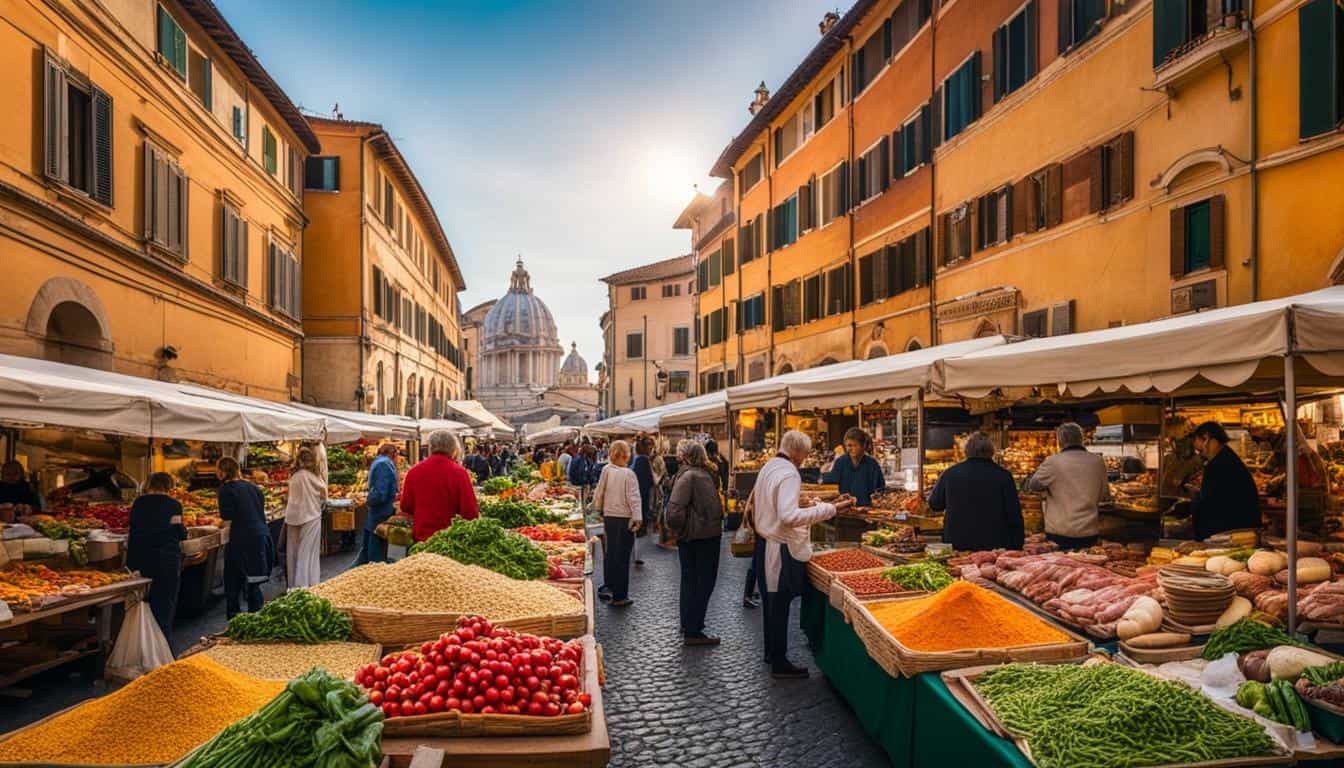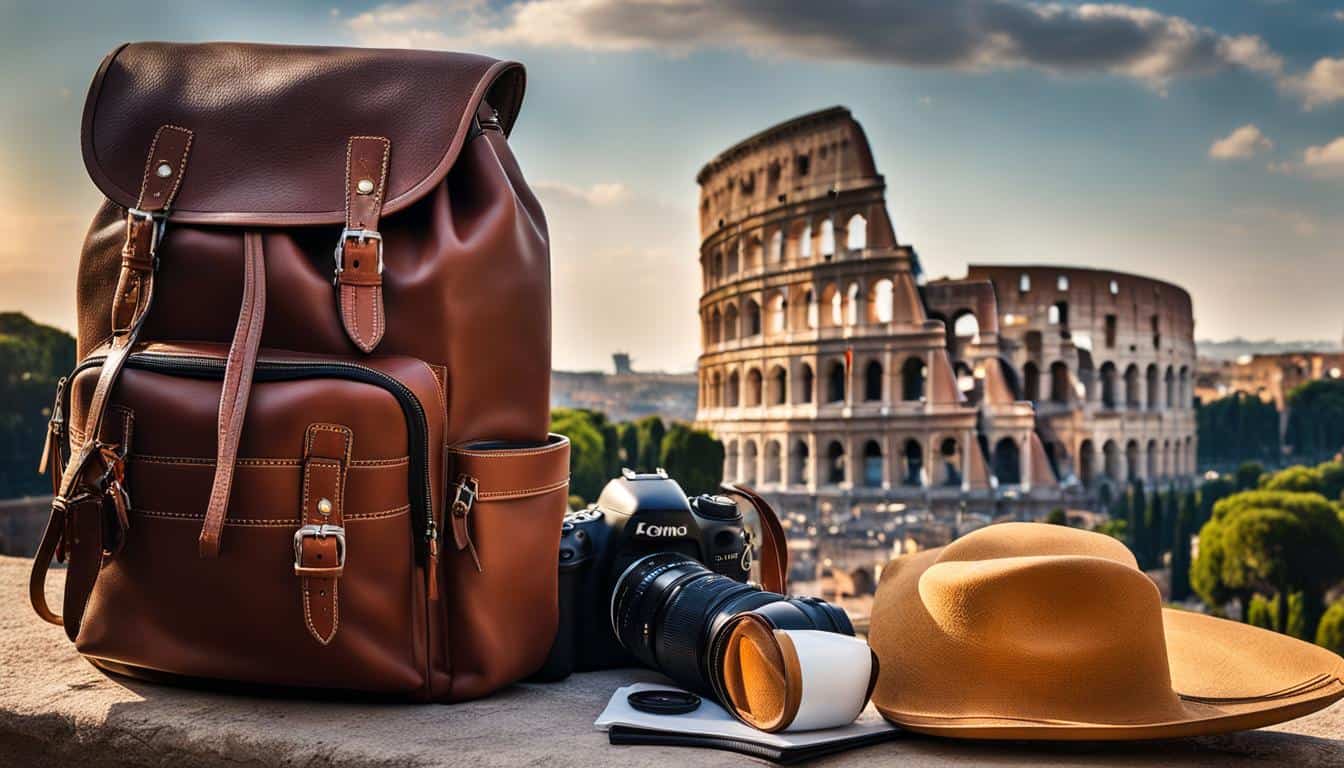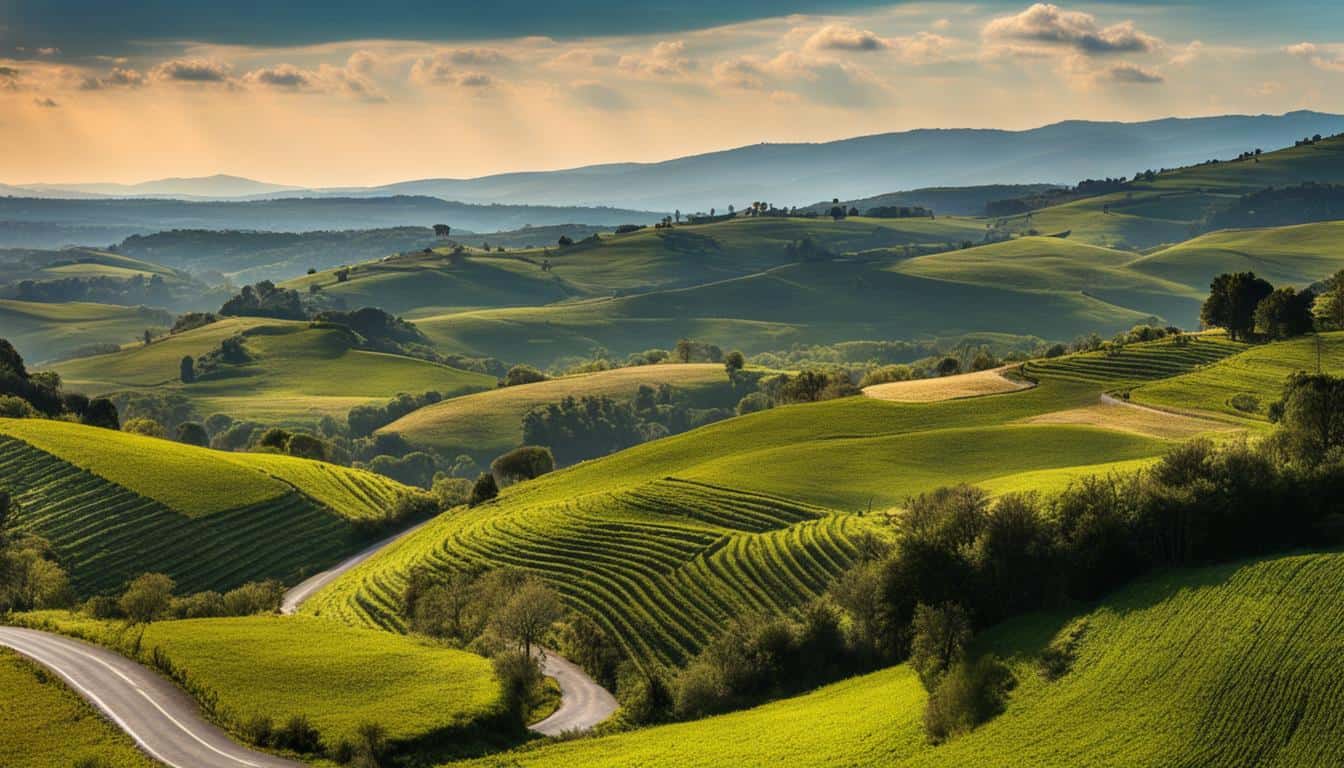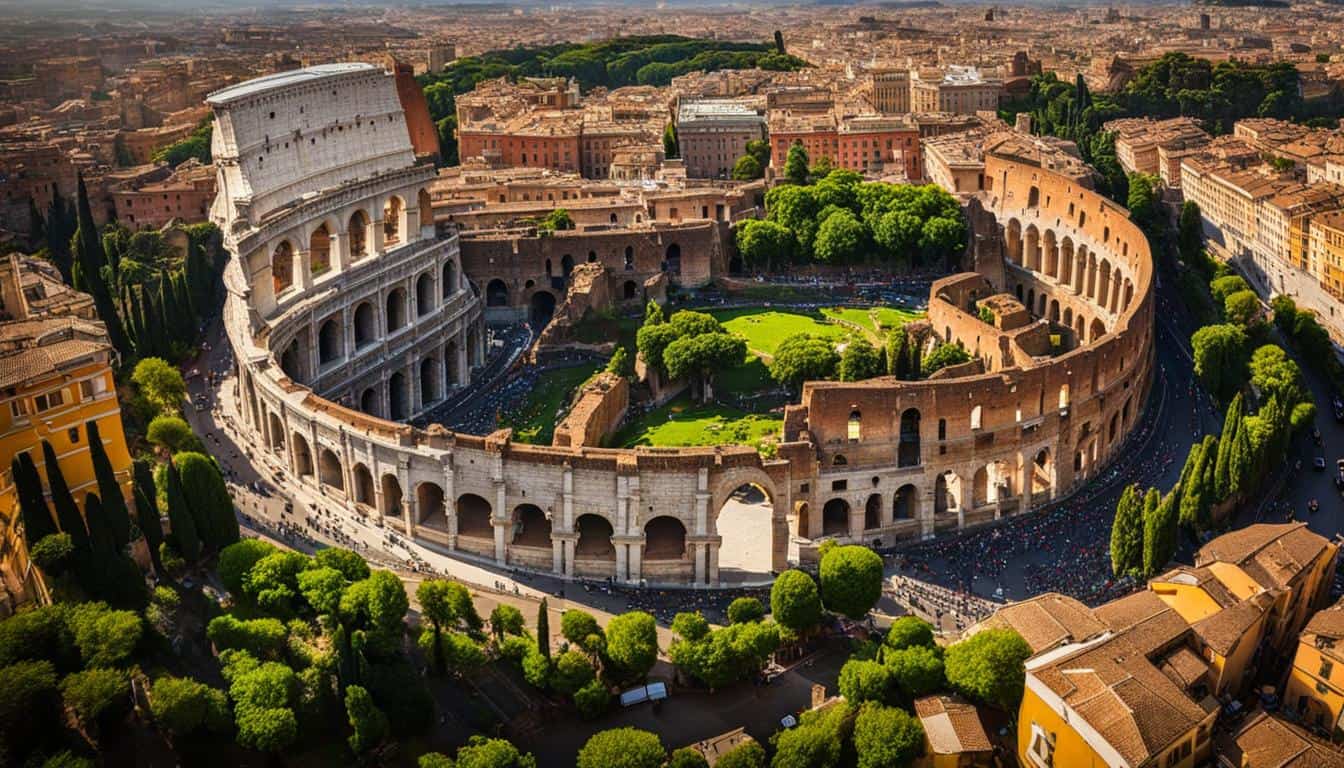Rome, the eternal city, is a captivating destination that seamlessly blends ancient ruins, Renaissance architecture, and vibrant neighborhoods. From the iconic Pantheon to the trendy streets of Monti, there is something to delight every traveler in Rome. Get ready to embark on a journey through time as you explore the rich history and discover hidden gems that will make your trip unforgettable.
Key Takeaways:
- Discover the best attractions and hidden gems in Rome.
- Get tips and tricks for exploring the city like a local.
- Learn about the best neighborhoods and hotels to stay in.
- Uncover the must-see sights and landmarks in Rome.
- Indulge in Rome’s food culture with the best restaurants and local cuisine.
Getting to Rome: Airports and Public Transport
Traveling to Rome is an exciting journey filled with anticipation for the adventures that await you in this ancient city. When it comes to getting to Rome, you have two main options: Fiumicino Airport and Ciampino Airport. Fiumicino is the larger of the two and serves as the primary international airport, while Ciampino is mainly used by budget airlines and for domestic flights. Whichever airport you arrive at, there are several transportation options to get you to the city center.
| Transportation Method | From Fiumicino Airport | From Ciampino Airport |
|---|---|---|
| Train | The Leonardo Express train is the most popular option for traveling from Fiumicino Airport to Rome’s Termini Station. The journey takes around 30 minutes. | There is no direct train from Ciampino Airport to the city center. However, you can take a bus to Anagnina Metro Station and then connect to the metro system. |
| Bus | The Terravision and Sitbusshuttle companies operate regular bus services from Fiumicino Airport to Termini Station and other key locations in Rome. | Several bus companies offer transfers from Ciampino Airport to Termini Station. The journey takes approximately 40 minutes. |
| Taxi | Taxis are readily available at both airports. It’s advisable to use official taxis with fixed rates to avoid scams. | Taxis are also available at Ciampino Airport, providing a convenient way to reach your destination in Rome. |
Once you’ve arrived in Rome, the city’s public transport system makes it easy to navigate and explore. The ATAC operates an efficient subway system (referred to as the “Metropolitana” or “Metro”) with three lines that cover most of the city. Buses are also a popular mode of transportation, offering extensive coverage throughout Rome. A single ticket is valid for both the metro and bus, making it convenient to switch between the two modes of transport. Remember to validate your ticket before boarding.
Now that you know the best ways to get to Rome from the airports and how to navigate the city using public transport, you’re ready to embark on your Roman adventure! Whether you’re here to immerse yourself in history, indulge in delectable cuisine, or simply soak up the vibrant atmosphere, Rome has something for everyone.
Where to Stay in Rome: Best Neighborhoods and Hotels
When planning your trip to Rome, one important consideration is where to stay. The city offers a range of neighborhoods and accommodations to suit different preferences and budgets. Here are some of the best neighborhoods and hotels to help you make your decision.
The Centro Storico
The Centro Storico, or historic center, is a popular choice for travelers looking to immerse themselves in Rome’s rich history. This neighborhood is home to iconic attractions like the Colosseum, Roman Forum, and Trevi Fountain. It also offers charming cobblestone streets lined with shops, cafes, and restaurants. Consider staying at luxurious hotels like the Hotel de Russie or the Hotel Raphael for a truly memorable experience.
Monti
For those seeking a more local and authentic experience, Monti is the neighborhood to explore. This trendy area is known for its bohemian atmosphere, with quirky boutiques, art galleries, and hip bars. Stay at boutique hotels like the Nerva Boutique Hotel or the Monti Palace Hotel to be in the heart of this vibrant neighborhood.
Testaccio
If you want to experience Rome like a true local, consider staying in Testaccio. This residential neighborhood is known for its authentic Roman cuisine, with traditional trattorias and local markets. It’s also home to a lively nightlife scene and the Testaccio Market, where you can sample local delicacies. Stay at the Roma Trastevere Relais or the Hotel Re Testa for a taste of the local culture.
| Neighborhood | Hotel Recommendations |
|---|---|
| The Centro Storico | Hotel de Russie |
| Hotel Raphael | |
| Monti | Nerva Boutique Hotel |
| Monti Palace Hotel | |
| Testaccio | Roma Trastevere Relais |
| Hotel Re Testa |
“Staying in the Centro Storico allows you to walk to some of Rome’s most famous attractions, like the Colosseum and Trevi Fountain. Monti and Testaccio offer a more local and off-the-beaten-path experience, with their charming streets and authentic cuisine.” – Traveler’s Review
Top Things to Do in Rome: Explore the City’s Must-See Sights
Rome, the Eternal City, is a treasure trove of iconic sights and attractions that showcase its rich history and vibrant culture. From ancient ruins to Renaissance masterpieces, there is no shortage of things to do and see in this incredible city. Whether you’re a history buff, an art enthusiast, or a food lover, Rome has something to offer everyone.
One of the top attractions in Rome is the Colosseum, an ancient amphitheater that once hosted gladiatorial contests and other spectacles. Step back in time as you explore the massive structure and imagine the roar of the crowd. Just nearby, you can explore the Roman Forum, a sprawling archaeological site that was once the heart of the Roman Empire.
No visit to Rome is complete without a trip to the Vatican City, the smallest independent state in the world. Marvel at the grandeur of St. Peter’s Basilica, home to stunning Renaissance art and the tomb of St. Peter himself. Don’t forget to visit the awe-inspiring Sistine Chapel, where you can admire Michelangelo’s famous ceiling frescoes.
As you stroll through the streets of Rome, you’ll come across countless other attractions that embody the city’s charm. Toss a coin into the Trevi Fountain to ensure your return to Rome, climb the Spanish Steps for a panoramic view of the city, and wander through the picturesque Piazza Navona to soak up the atmosphere.
Table: Must-See Sights in Rome
| Attraction | Description |
|---|---|
| Colosseum | An ancient amphitheater where gladiators once battled |
| Roman Forum | The ruins of the ancient city center of Rome |
| Vatican City | The smallest independent state in the world, home to St. Peter’s Basilica and the Sistine Chapel |
| Trevi Fountain | A grand fountain where tossing a coin ensures your return to Rome |
| Spanish Steps | A monumental stairway with a beautiful view of the city |
| Piazza Navona | A charming square with stunning fountains and lively atmosphere |
Aside from these famous attractions, Rome is also home to numerous parks, museums, and galleries that offer a deeper exploration of its art and culture. Visit the peaceful Villa Borghese gardens for a relaxing stroll amidst beautiful sculptures and fountains. Immerse yourself in art at the Galleria Borghese, which houses a remarkable collection of masterpieces by artists such as Caravaggio and Bernini.
With its rich history, breathtaking architecture, and vibrant atmosphere, Rome truly has something for everyone. Whether you’re exploring ancient ruins, admiring world-renowned art, or indulging in the city’s delectable cuisine, you’re bound to create unforgettable memories in the Eternal City.
Indulge in Rome’s Food Culture: Best Restaurants and Local Cuisine
When visiting Rome, one experience that should not be missed is immersing yourself in the city’s vibrant food culture. From traditional Roman dishes to innovative culinary creations, Rome offers a plethora of dining options that will delight your taste buds. Here are some of the best restaurants in Rome where you can indulge in delicious cuisine:
Roscioli
Located in the heart of Rome’s historic center, Roscioli is a renowned restaurant that showcases the rich flavors of traditional Roman cuisine. From homemade pasta dishes like carbonara and cacio e pepe to mouthwatering tiramisu for dessert, every bite is a celebration of local flavors. The restaurant also has an extensive wine list, allowing you to pair your meal with the perfect vintage.
Trattoria da Cesare al Casaletto
If you want to experience authentic Roman cuisine in a cozy and casual setting, head to Trattoria da Cesare al Casaletto. This family-run trattoria is known for its delicious house specialty, the “coda alla vaccinara” – oxtail stewed in a rich tomato sauce. Other must-try dishes include the “abbacchio al forno” (roast lamb) and the homemade pasta with ragu sauce.
Pizzarium
For pizza lovers, Pizzarium is a must-visit. This small and unassuming pizzeria has gained worldwide fame for its innovative and mouthwatering pizza slices. With a wide variety of toppings and flavors, including vegetarian and vegan options, Pizzarium offers a unique twist on the classic Roman pizza. Don’t forget to pair your slice with a refreshing craft beer.
When dining in Rome, be sure to also explore the local markets, such as Campo de’ Fiori and Trionfale Market. Here, you can discover fresh produce, local specialties, and interact with friendly vendors. Rome’s food culture is a true reflection of its rich history and culinary heritage, making it an unforgettable experience for food enthusiasts.

Table: Top Restaurants in Rome
| Restaurant | Specialty |
|---|---|
| Roscioli | Traditional Roman cuisine |
| Trattoria da Cesare al Casaletto | Oxtail stew and roast lamb |
| Pizzarium | Innovative pizza slices |
Whether you choose to dine at a Michelin-starred restaurant or savor street food in a bustling market, Rome’s culinary scene will leave you craving for more. So, make sure to explore the city’s best restaurants and local cuisine to truly indulge in the flavors of this remarkable city.
Tips for Traveling in Rome: Currency, Language, and Tipping Etiquette
When traveling to Rome, it’s important to be prepared with some essential tips to make your trip smooth and enjoyable. Here are some useful travel tips for navigating the Eternal City:
1. Currency in Rome
The official currency in Rome is the Euro (€). It is widely accepted throughout the city, and you can easily withdraw cash from ATMs or exchange currency at banks and exchange offices. Most establishments, including hotels, restaurants, and shops, also accept credit cards, so it’s convenient to use plastic for your transactions. However, it’s advisable to carry some cash for smaller vendors and places that may not accept cards.
2. Language in Rome
The official language in Rome is Italian, but many locals, especially those working in the tourism industry, speak English. In popular tourist areas, you’ll find that most people can communicate in English, making it easier for visitors. However, learning a few basic phrases in Italian, such as greetings and polite expressions, can go a long way in showing respect and enhancing your cultural experience.
3. Tipping Etiquette
Tipping in Rome is not mandatory but is appreciated for excellent service. In restaurants, it is common to leave a small amount of around 10% as a gesture of appreciation. Some restaurants may include a service charge, indicated as “servizio incluso” on the bill, so make sure to check before leaving an additional tip. For other services, like taxis and hotel staff, rounding up the bill or leaving a few euros is a polite gesture. However, tipping is entirely discretionary, so feel free to follow your judgment based on the quality of service you receive.
| Service | Tipping Etiquette |
|---|---|
| Restaurants | Around 10% if service charge not included |
| Taxis | Rounding up or small change |
| Hotel Staff | Rounding up or small gratuity |
By keeping these travel tips in mind, you’ll be well-prepared to navigate Rome and make the most of your visit. Remember to respect the local culture, embrace the language, and enjoy the unique experiences Rome has to offer.
Best Time to Visit Rome and What to Pack for Your Trip
Rome can be visited year-round, but the best time to visit is during the spring (April to June) and fall (September to October). The weather during these seasons is pleasant, with temperatures ranging from 60°F (15°C) to 75°F (24°C), making it ideal for exploring the city’s outdoor attractions. These months also offer fewer crowds compared to the peak summer season, allowing you to enjoy the sights and museums with more ease.
During the summer months of July and August, Rome experiences high temperatures, often reaching above 90°F (32°C). Additionally, this is the peak tourist season, meaning popular attractions can get crowded, and prices for accommodations may be higher. If you plan to visit during this time, it’s important to stay hydrated, wear sunscreen, and take breaks in shaded areas to avoid heat exhaustion.
Winter in Rome, from November to February, is mild but can be rainy. The temperatures range from 45°F (7°C) to 60°F (15°C), and while the city is less crowded, some attractions may have shorter opening hours or be closed for maintenance. It’s advisable to pack a light jacket or sweater, as well as a compact umbrella, to be prepared for occasional rain showers.
What to Pack for your Trip to Rome
When packing for your trip to Rome, it’s essential to pack comfortable footwear, as you’ll be doing a lot of walking on cobbled streets and uneven surfaces. A pair of sturdy walking shoes or sneakers is recommended. Additionally, pack lightweight, breathable clothing to stay comfortable in the city’s warm weather. Opt for materials like cotton or linen that allow your skin to breathe.
- T-shirts and shorts for the day
- Lightweight trousers or skirts
- A scarf or shawl for visiting churches that may require modest dress
- A light jacket or sweater for cooler evenings
- A hat and sunglasses for sun protection
- A small backpack or tote bag to carry your essentials during the day
- Don’t forget to bring a power adapter for your electronics if you’re traveling from outside of Europe
Lastly, don’t forget to pack some essentials like sunscreen, a reusable water bottle, and a small first aid kit for any minor injuries or discomforts you may encounter. With these items in your suitcase, you’ll be well-prepared for your memorable trip to Rome.
| Season | Best Time to Visit | Weather |
|---|---|---|
| Spring (April to June) | Pleasant temperatures, fewer crowds | 60°F (15°C) to 75°F (24°C) |
| Fall (September to October) | Pleasant temperatures, fewer crowds | 60°F (15°C) to 75°F (24°C) |
| Summer (July to August) | Hot temperatures, crowded attractions | Above 90°F (32°C) |
| Winter (November to February) | Mild temperatures, occasional rain | 45°F (7°C) to 60°F (15°C) |

Day Trips from Rome: Explore the Surrounding Regions
While Rome itself offers a wealth of attractions and experiences, taking day trips to the surrounding regions allows you to delve deeper into the beauty and history of Italy. Whether you’re seeking picturesque towns, ancient ruins, stunning gardens, or charming cities, these excursions from Rome will provide a diverse range of destinations to explore.
Picturesque Frascati:
Located just a short distance from Rome, Frascati is a picturesque town known for its beautiful landscapes, charming architecture, and renowned vineyards. Take a stroll through the historic center, where you’ll find quaint streets lined with colorful buildings, local shops, and cozy cafes. Don’t miss the opportunity to visit one of the many wineries in the area, where you can sample the famous Frascati wine and enjoy breathtaking views of the surrounding countryside.
Ancient Ostia Antica:
Step back in time and explore the ancient ruins of Ostia Antica, a well-preserved archaeological site that was once a thriving Roman port city. Walk along the cobbled streets and marvel at the remarkably preserved buildings, including the amphitheater, baths, and houses. This fascinating excursion offers a glimpse into the daily life of ancient Romans and provides a unique perspective on the history of the Roman Empire.
Enchanting Tivoli:
Escape the bustling city and discover the enchanting gardens and villas of Tivoli. Visit Villa d’Este, a UNESCO World Heritage site renowned for its stunning Renaissance gardens, elaborate fountains, and breathtaking views. Explore the ruins of the ancient Roman Villa Adriana, a sprawling complex built by Emperor Hadrian, and admire the intricate architecture and grandeur of the past. Tivoli offers a peaceful retreat from the city, where you can immerse yourself in nature and history.
Charming Orvieto:
Journey to the charming city of Orvieto, perched atop a volcanic hill and surrounded by picturesque vineyards and olive groves. Explore the narrow medieval streets and discover the magnificent Orvieto Cathedral, known for its intricate façade and stunning frescoes. Take a tour of the underground tunnels and caves that run beneath the city, offering a fascinating glimpse into its ancient past. With its rich history, beautiful architecture, and panoramic views, Orvieto is a hidden gem waiting to be discovered.
These day trips from Rome offer a chance to escape the city and explore the diverse regions that surround it. Whether you’re interested in history, nature, or simply experiencing the local culture, these excursions will provide unforgettable experiences that showcase the beauty and richness of Italy.
| Day Trip | Distance from Rome | Main Attractions |
|---|---|---|
| Frascati | Approximately 20 km | Historic center, vineyards, wine tasting |
| Ostia Antica | Approximately 30 km | Ancient ruins, amphitheater, baths |
| Tivoli | Approximately 30 km | Villa d’Este, Villa Adriana, Renaissance gardens |
| Orvieto | Approximately 110 km | Orvieto Cathedral, underground tunnels, panoramic views |

Conclusion
Congratulations on exploring Rome, the Eternal City! With its rich history, stunning architecture, and vibrant neighborhoods, Rome offers a truly unforgettable travel experience. Whether you’re an art enthusiast, history buff, or food lover, this city has something for everyone.
As you plan your trip, refer to this Rome travel guide to discover the best tourist attractions and get valuable travel advice. From iconic sights like the Colosseum and Vatican City to hidden gems like the Monti and Testaccio neighborhoods, Rome will captivate you at every turn.
Immerse yourself in the local culture by indulging in traditional Roman cuisine, exploring local markets, and dining at the city’s best restaurants. Don’t forget to pack comfortable footwear and lightweight clothing, as well as a light jacket for cooler evenings.
So, get ready to embark on an incredible adventure in Rome. Explore its wonders, soak in its history, and create memories that will last a lifetime. Enjoy your time in the Eternal City!
FAQ
When is the best time to visit Rome?
The best time to visit Rome is during the spring (April to June) and fall (September to October) when the weather is pleasant and the city is less crowded.
What are the main airports in Rome and how do I get to the city center?
Rome has two main airports, Fiumicino and Ciampino. From Fiumicino Airport, the most popular way to get to the city center is by train, while Ciampino Airport is well-connected by bus. Taxis are also available for a more convenient option.
What are the best neighborhoods to stay in Rome?
Rome offers a range of accommodations in different neighborhoods. The Centro Storico, Monti, and Testaccio are popular choices. Consider your preferences and budget when choosing where to stay in Rome.
What are the must-see attractions in Rome?
The Colosseum, Roman Forum, Palatine Hill, Vatican City, Trevi Fountain, Spanish Steps, and Piazza Navona are some of the must-see attractions in Rome. Don’t forget to explore beautiful parks like Villa Borghese and visit the art at the Galleria Borghese.
What are some traditional Roman dishes to try?
Traditional Roman dishes include cacio e pepe, carbonara, and supplì. Visit local markets like Campo de’ Fiori and Trionfale Market to discover fresh produce and local specialties. Dine at renowned restaurants like Urbana 47 and Nonna Betta to savor the flavors of Rome.
What should I know before traveling to Rome?
The currency in Rome is the Euro, and most establishments accept credit cards. While Italian is the official language, many locals speak English, especially in tourist areas. Tipping is not mandatory in Italy, but it’s common to leave a small amount for good service.
What should I pack for my trip to Rome?
Pack comfortable footwear, lightweight clothing, and a light jacket or sweater for cooler evenings. The weather in Rome can vary, so it’s advisable to check the forecast before your trip.
Are there any day trips I can take from Rome?
Yes, you can take day trips from Rome to explore the surrounding regions. Visit towns like Frascati or the ancient ruins of Ostia Antica. Explore the gardens of Tivoli or the charming city of Orvieto for a taste of the Italian countryside near Rome.
How can I make the most of my trip to Rome?
Use this tourist guide to plan your trip, discover the best things to do, and make the most of your time in the Eternal City. Rome offers a rich history, vibrant neighborhoods, and delicious cuisine, ensuring a truly memorable travel experience.
